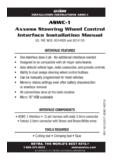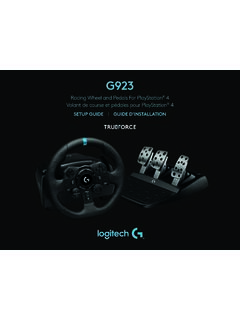Transcription of IN-WHEEL ELECTRIC MOTORS - Protean Electric
1 IN-WHEEL ELECTRIC MOTORS The Packaging and Integration Challenges Alexander Fraser Senior Mechanical Systems Engineer Protean ELECTRIC Ltd, UK ABSTRACT One of the fundamental advantages of IN-WHEEL MOTORS is that they free up packaging space on the vehicle platform. From retrofits to new vehicle designs, the freedom to add batteries, range extenders, or simply preserve cargo and passenger space is a major competitive advantage for all styles of IN-WHEEL motor over more conventional electrical machines. This advantage needs to be preserved by not having to re-locate the friction brake to a position on the sprung mass of the vehicle, so both MOTORS and brakes must be accommodated inside the wheels of a vehicle.
2 To preserve as much of the retrofit market as possible, it must be ensured that the packaging solution inside the wheel does not require significant platform tear-up. In addition, the whole system must be safe, reliable, and provide credible vehicle performance. This has led to some radically different IN-WHEEL motor concepts being developed by various organisations around the world. Protean 's unique solution to this packaging problem was, on the face of it, a bold one for a start-up company; displace the brake to provide space for a motor , and develop a new packaging philosophy for the unsprung assembly incorporating both brake and motor .
3 By working with an expert partner on the braking side, this, we believe, results in a much more harmonious use of the valuable space inside the wheel than other IN-WHEEL solutions, and meets or exceeds all the requirements outlined above. This presentation will provide details of the process that resulted in the Protean design, as well as highlight the engineering of the solution fitted to the front axle of the high performance Protean /Brabus E-Class vehicle. Figure 1: Unsprung assembly, Protean /Brabus E-class front-left corner. TARGET MARKETS AND REQUIREMENTS OVERVIEW Protean ELECTRIC is targeting both passenger vehicles and light commercials with a blank sheet ELECTRIC motor design wholly dedicated to IN-WHEEL applications.
4 Principally, the motor must be capable of being the sole source of tractive power for an ELECTRIC vehicle or series hybrid, but must also work alongside conventional internal combustion powertrains to enable parallel hybrid architectures. To keep costs down, 2WD is an absolute must on smaller vehicles and hybrids, and 4WD should lend credible performance to larger, heavier executive saloons and SUVs. The performance of these vehicles should be able to squarely address the market segment the vehicle is in with the performance, range and interior space that a demanding customer requires. A key requirement that drives the Protean motor design is retro-fit ability.
5 Clearly an IN-WHEEL motor equipped powertrain opens up so many possibilities for sprung mass packaging and design changes that any vehicles that are designed from the ground-up around IN-WHEEL MOTORS will have their own protracted development cycles measured on the scale of several years. Balanced against this, OEMs need to remove significant amounts of carbon emissions from their entire fleet right now, and a handful of compromised niche vehicles will not achieve this. The ability to engineer a hybrid or full EV on an existing platform, with minimal tear-up of existing hardware or intrusion into passenger, storage or accident-vulnerable space cannot be underestimated and is one of the main advantages of choosing an IN-WHEEL motor to propel a vehicle.
6 It is therefore highly desirable for an IN-WHEEL motor to be able to be fitted to a car without requiring any special wheel design or requiring risky suspension modifications, and this played a large part in the development of the requirements for the Protean motor . Regardless of the general architecture and form of an IN-WHEEL motor , the unsprung environment is a harsh one compared with the on-body requirements for a motor . The wading requirements of the vehicle mean that the motor needs to operate whilst essentially submerged, and the wheelhouse is subject to great extremes of temperature thanks to the friction brake and rejected heat from any on-body ICE powertrain.
7 For a road vehicle the motor must survive repeated shock loads of up to 50g with continuous vibration spectra of up to 20g RMS for severe rough roads. Stones are expected to impact any exposed face of the device and the cabling to the motor must be able to survive repeated bending and articulation with suspension and steering movement at temperatures well below zero.[1] The main challenge however will always be package space, especially with a retro-fittable design. In appreciating this, it is clear that Nm/litre and kW/litre have to be maximised. It is already well known that the best motor technology for volume specific performance is liquid-cooled brushless permanent magnet, and so early-on in the programme the decision was made to focus on this technology for the first high volume production motor that Protean is developing.
8 TORQUE AND POWER REQUIREMENTS The principal purpose of the drivetrain is to deliver tractive motoring effort to the tyre-road interface. As a free bonus, an ELECTRIC drivetrain has the potential to apply similar tractive effort in the braking domain and hand a sizeable chunk of the vehicle s kinetic energy back into the battery. Safety and/or regulatory concerns aside, on first consideration it is tempting to believe that friction brakes can be replaced entirely with the ELECTRIC drivetrain but a few simple calculations show the cost of such a move. Take for example a relatively light 2WD passenger vehicle at 1500kg. Assuming a certain few key parameters it is quickly shown that the torque and power requirements are much greater in the braking domain than they are in motoring for a given wheel .
9 Torque o Motoring - Pull-away torque for 30% grade = 650Nm (per motor ) o Motoring - Maintaining 100mph at 6% grade =300Nm (per motor ) o Braking - 1g braking = 1800Nm (per front wheel ) Power o Motoring - Maintaining 100mph at 6% grade = 40kW (per motor ) o Braking - Deceleration at a rate of 1g at 100mph = 250kW (per front wheel ) Fundamentally this is because the vehicle is always required to be able to perform an emergency stop from all speeds during normal operation, but forward tractive forces do not need to be anywhere near as large as braking forces in order to provide credible or even sporty forward vehicle performance. A universal truth of passenger vehicles is that the most powerful actuator on the vehicle is not the power-train, it is the brake system.
10 It is important to note that the majority of this braking effort is carried out by the front wheels. In targeting 4WD applications, and not discerning (at the requirements level) between RWD or FWD in the case of a 2WD drivetrain, Protean clearly has to cater for, or not prevent, the provision of these levels of braking power and torque in its motor design If the motor were designed to be able to create the levels of retarding torque required in braking, it is shown by the example above that the motor would need to produce around three to four times more wheel torque and over five times more wheel power than if it were sized for even sporty forward performance.



